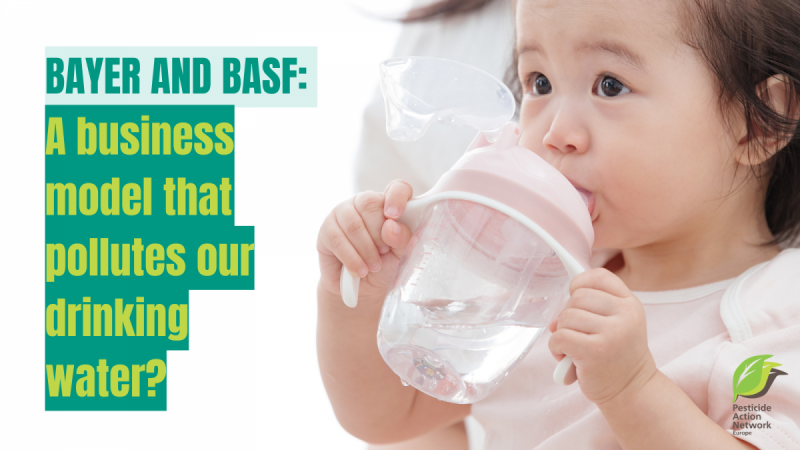There is a ticking time bomb in our water. It is Trifluoroacetic acid (TFA), a very small PFAS. Our recent reports showed its presence in water all over Europe. TFA and its salts are extremely soluble, mobile and persistent. With time it will reach the groundwater even in the deep layers. And yes, it is also in the water we drink as our latest report shows. For a long time, it has been considered by the authorities as non-relevant and hardly toxic. Recent studies have shown otherwise. So to avoid worse, we have to drain the source of the pollution. The main responsible for TFA in our water are a group of PFAS pesticides. The most used is the herbicide Flufenacet. It is sold in Bayer products like Bastille, Fosburi, Gofer and Promess and in BASF products like Chocker, Crespa, Pontos and Shooter. How long can they stay on the market?
TFA generator Flufenacet has been sprayed on fields in the EU since January 2004. Its licence originally expired in December 2013. The European authorities have not managed to finalise the evaluation to conclude on a ban or renewal even since. Awaiting the conclusion, the authorisation has been prolonged year after year for an incredible 11 and a half years. During this time when authorities were too slow to take their responsibility, masses of TFA generated by this PFAS pesticide has done its polluting work. With far-reaching consequences, for now, we find it in water almost everywhere.
A major factor in the failure of the regulatory authorities is the blunder of designating TFA as a non-relevant metabolite back in 2003. This year, TFA was mentioned as a groundwater contaminant in the approval process of the active substance flurtamone. The EU authorities did recognise that the toxicological information provided to the competent committee was insufficient to conclude on its toxicity for humans but nevertheless classified TFA as a ‘non-relevant’ metabolite. It opened the door for the (re)authorisation of a whole group of PFAS pesticides (1).
TFA is not only persistent and very mobile, there are indications that it is toxic to reproduction and possesses the same ability as other PFAS to damage our liver and possibly our immune system. Very recently, in 2024, the German Office for Chemicals proposed the EU Chemical Agency ECHA to classify TFA as toxic for reproduction 1B. In a recent letter to the EU SCoPAFF committee PAN Europe has asked the EU Member States to ban all PFAS pesticides since they break down to TFA and do not comply anymore with the EU law (2).
One of the TFA generators is Flufenacet. According to its renewal dossier, flufenacet degrades into TFA in soil. This leads to its leakage into groundwater in amounts above 0.75µg/L for all representative uses. According to the Pesticide Regulation, metabolites of pesticide-active substances which qualify for classification as toxic for reproduction shall be considered ‘relevant’ metabolites and shall not be detected in groundwater in a concentration exceeding 0.1 µg/L. In case this threshold exceeds, the active substance cannot be (re)approved.
However, there is more to Flufenacet itself. In September 2022 experts of EFSA’s Endocrine Disruptors working group concluded that it is an endocrine disruptor for humans and non-target organisms. It should be banned for that reason alone according to the EU Pesticide Law. PAN Europe requested EFSA on July 2nd to swiftly complete the peer review of flufenacet based on its endocrine-disrupting properties (3).
Where does the TFA come from
Apart from industrial pollution, the main sources of TFA are PFAS pesticides, F-gases used in refrigerants and other chemicals that contain CF3 groups. The German Umweltbunderamt wrote: “Of the utmost significance seem to be chemicals which are discharged into the environment in large quantities during their application and then degrade in the environment. These chemicals include, in particular, plant protection products, refrigerants and blowing agents, biocides, but also veterinary and human pharmaceuticals.” Further investigations into the source of TFA led to the following estimation in tons for Germany (based on 2016-2018 figures) (5).
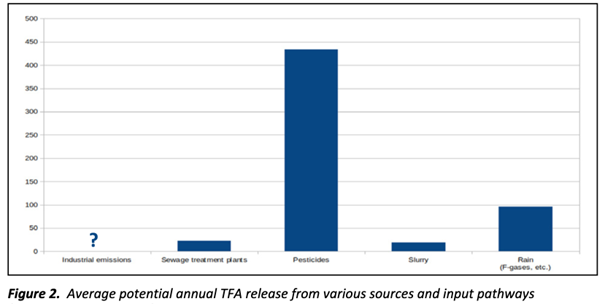
Which PFAS pesticides are the main sources of TFA?
The German Umwelt Bundesamt (UBA) has done some research as well. Not surprisingly, the most used PFAS pesticides are also the most likely source of TFA. For Germany, Flufenacet is the TFA champion, next comes the herbicide Diflufenican (also Bayer and BASF) and the fungicide Fluazinam (Syngenta).
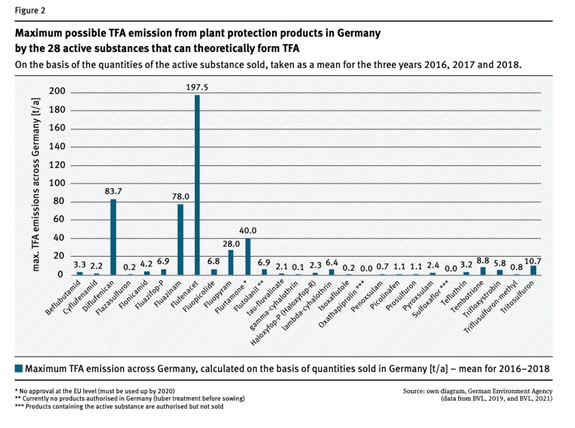
Beware, this is based on 2016-2018 figures. Since then the sales and use of Flufenacet has increased by some 50%.
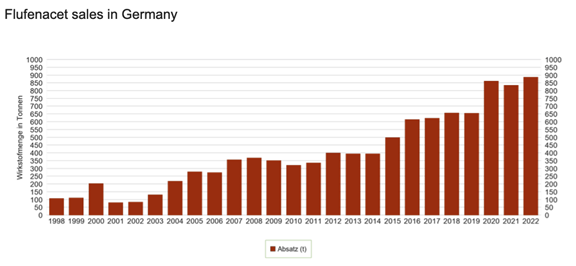
This is not only the case in Germany. In France, the sales of PFAS pesticides have tripled in 13 years.
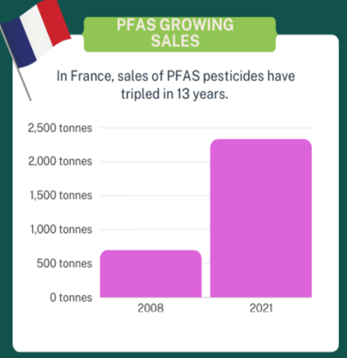
Flufenacet was the top-selling PFAS pesticide also in France, with 804 tonnes in 2021 (6).
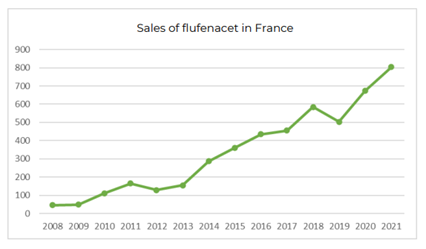
The business case that pollutes our drinking water
Failure in supervision by the authorities is not a license to pollute water. The companies that cause the pollution carry their own responsibility. Court rulings, for example, on PFAS producers 3M and Chemours clearly show that companies cannot remain apathetic even if they have a licence. So since when did those responsible in Bayer and BASF know about the harmful effects of Flufenacet and its metabolite TFA? What did they do to end it? Nothing visible yet. Flufenacet is a top-selling product and there is no signal of any movement to change that. On the contrary, the sales are on the rise.
“The Global Flufenacet market was valued at $540 million in 2023 and is projected to surpass the market size of $855,4 by 2032”, according to a recent market analysis (7).
However, the producers do know that both Flufenacet and its metabolite TFA are a problem. They surely know it for years now, as they themselves had to sponsor the studies that show some of the problems. At some point, we might find out that they have known for much longer, without taking any responsibility. This could end badly, as it was shown in the case of DuPont. Internal documents showed this company already knew in 1984 of the dangers of PFOA water pollution around their Parkersburg in Virginia, USA. They didn’t tell anyone for many years. This led US and Dutch courts to find the company liable for the contamination caused by their products.
Much closer to Bayer, we have also seen a similar effect in the Monsanto Glyphosate cancer court cases in the US. Bayer-Monsanto knew about the cancer potential of glyphosate but didn’t tell the public. And the same goes for another very toxic Monsanto legacy inherited by Bayer. The very persistent and toxic group of PCB chemicals can still be detected everywhere on our planet. Those responsible for their production knew many years before it was finally stopped that there was a very serious problem with these substances.
Libel and criminal prosecution
Knowing about dangers and not action is not only a liability. It could also be considered a criminal act. The definition of ecocide by the International Stop Ecocide panel is an "unlawful or wanton acts committed with knowledge that there is a substantial likelihood of severe and either widespread or long-term damage to the environment being caused by those acts" (8).
Ecocide is not officially recognised as an international crime yet, but there is more and more support to include it in penal law. In the meantime, the new European Environmental Crime Directive went into force this year. Here we can find elements that could be useful to sue offenders that willingly pollute our water.
Article 3 lists the offences, providing that: 'Member States shall ensure that the following conduct constitutes a criminal offence, when unlawful and committed intentionally or with at least serious negligence: (a) the discharge, emission or introduction of a quantity of materials or ionising radiation into air, soil or water, which causes or is likely to cause death or serious injury to any person or substantial damage to the quality of air, the quality of soil or the quality of water, or to animals or plants.’
In the case of TFA, a very clear link can be seen: it causes substantial damage to the quality of water (9).
You don’t have to be clairvoyant to see that it is highly likely that deliberately polluting our drinking water will at some point be considered an environmental crime. The managers of chemical companies should be aware of their heavy responsibility and the risks they take. Can they look their grandchildren in the face and confess “I was one of the people responsible for polluting your water”?
Irresponsible behaviour could also instigate libel cases against the perpetrators. Shareholders of companies like Bayer and BASF would be wise to closely watch this ticking time bomb under their investments. This applies even more for pension funds and other institutions with social goals that hold this kind of shares. Owning these shares could someday turn from what looked like a secure investment into a worthless rag.
Socials
TFA is a ticking time bomb for our water. This small PFAS is the mobile and persistent breakdown product of PFAS pesticides. Producers like Bayer and BASF know this. Will they try to reduce their liability by taking the products from the market? Or do they prefer to continue to deliberately pollute our water? That could lead to criminal prosecution at some point. It could also lead to the type of libel cases that Bayer knows all too well from Monsanto’s toxic glyphosate and PCB heritage.
Notes
- Page 8: TFA in Water, Dirty PFAS Legacy Under the Radar
- Point 10: PAN Europe letter Letter to SCoPAFF
- Letter to EFSA, 2 July 2024
- EU Environmental Crime Directive
- Page 52: Trifluoracetat (TFA): Grundlagen für eine effektive Minimierung schaffen - Räumliche Analyse der Eintragspfade in den Wasserkreislauf, 2023
- Europe’s toxic Harvest, unmasking PFAS pesticides authorised in Europe, PAN Europe and Générations Futures, November 2023
- Astute Analytica, Flufenacet Market Scenario
- Stop Ecocide
- EU Environmental Crime Directive
